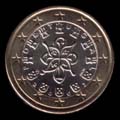Catalog of Portuguese coins in escudo and euro
| Euro | Third Republic |
| 2002 - | 1975 - 2001 |
 |
 |
| Estado Novo | First Republic |
| 1926 - 1974 | 1910 - 1926 |
 |
 |
- Click the images to get additional information
- Catalog available also listed by value
History of the Portuguese Coins
Portuguese dinheiro
Portugal's independence was proclaimed by Afonso Henriques after the Battle of Ourique on 25 July 1139, recognized as King Alfonso I (1128-1185) by the King of León and Castile Afonso VII in 1143, and by Pope Alexander III in 1179.
On 1179 the king adopted as currency of Portugal the dinheiro, used until 1433. The obverse of this coin had a large cross, as usual on the medieval coins. Its reverse had five shields arranged to form a cross, each of them with five dots, in memory of the five Moorish kings defeated by Alfonso I at the battle of Ourique. The shields is currently in Portugal's national arms.
The dinheiro comes from the monetary reform of Charlemagne, who established a standard based on the livre carolinienne in silver (the modern pound from the Roman libra), subdivided in 20 sous (the modern shilling from the Roman solidus) or 240 deniers (the modern penny from the Roman denarius). Coins derived from the French denier were the British pound, the Italian lira, the Spanish dinero and the Portuguese dinheiro.
As for the counting units, 12 dinheiros equaled one soldo and 20 soldos are equal to one libra: the denomination of half a dinheiro was called mealha. New coins introduced in the following centuries were the gold morabitino, introduced by Sancho I (1185-1211) from the Spanish maravedí and equivalent to 15 soldos, and the silver tornês, introduced by the King Denis one century later which worth 5½ soldos.
Portuguese real
King Ferdinand I introduced in 1380 the gold dobra, which worth 6 libras, and the silver real, which worth 10 soldos (120 dinheiros or ½ libra). The name real comes from the Spanish silver coin issued by King of Castile and Leon Peter I (1350-1369) with the name of nummus realis, that means money of the king. Real was also the name of a former silver coin in Spain and Spanish America, worth the eighth part of a peso.
King João I (1385-1433) introduced a new real, known as the real branco, in bullion having a value of 70 soldos (equivalent to 840 dinheiros), adopted as unit of account by King Duarte I, João I's successor, in 1433. Moreover, also the real preto of one tenth of a real branco (equivalent to 7 soldos) was issued in copper. During the reign of Manuel I (1495–1521), the name real branco was simplified to real, start minting real coins in copper.
Two denominations related to the real were the vintém, with a value of 20 réis, and the tostão, with a value of 100 réis.
In the 1580s were minted the last 1 real coins. After this time, the smallest coins minted was the 1½ réis until around 1750, after which the smallest circulating denomination became the three réis coin, issued until 1875. The denominations of 3, 5, 10, 20 and 40 réis were in copper, denominations of 50, 60, 100, 120, 240 and 480 réis were in silver, and 480, 800, 1200, 1600, 3200 and 6400 réis were in gold. The standard gold coin was 6400 réis, called peça, that increased its value to 7500 réis after 1826.
In 1837 was adopted the decimal system for the minting of the coins, using copper at the beginning and bronze from 1882 for 3, 5, 10 and 20 réis deniminations, silver coins for 50, 100, 200, 500 and 1000 réis denominations, and gold 1000, 2000, 2500, 5000 and 10,000 réis denominations. In 1900 the 50 and 100 réis denominations were issued in cupro-nickel.
In 1847 the Banco de Portugal issued the first banknote. In 1854, Portugal adopted the gold standard with a ratio of 1000 réis = 1.62585 grams fine gold, gold standard was maintained until 1891.
Portuguese cruzado
The Cruzado was a gold coin issued by Afonso V (1438-1481) trying to organize a crusade against the the fall of Constantinople by the Turks in 1453. It had a value of 400 reis. The name comes from Portuguese cruzado which means cross, referring to the cross of the patron saint of Portugal, St George, on the reverse.
King João II (1477-1495) introduced a new silver coin called cruzado at a value of 324 real branco. João III (1521-1557) fixed its value to 400 réis and Pedro II (1683-1706) increased its value to 480 réis. The cruzado was also minted by João IV (1640-1656) with value equal to 750 réis.
Portuguese escudo
On May 22, 1911, after the 1910 Portuguese Republican revolution, the Portuguese escudo replaced the real with the ratio of 1,000 réis = 1 escudo. The name escudo comes from the Portuguese for "shield" and the ISO 4217 code of the escudo currency was PTE.
The escudo is subdivided into 100 centavos and its symbol is the cifrão, a capital S with two strokes in the middle. Values in escudos are expressed in the form escudos$centavos using the cifrão as the decimal separator.
Portuguese euro
The euro was introduced in Portugal on January 1st, 1999, replacing the escudo from circulation on 28 February 2002, with coins in escudo being exchangeable for euro until December 31, 2002
